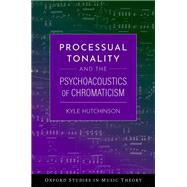Processual Tonality and the Psychoacoustics of Chromaticism
, by Hutchinson, Kyle- ISBN: 9780197800270 | 0197800270
- Cover: Hardcover
- Copyright: 11/4/2025
Processual Tonality and the Psychoacoustics of Chromaticism presents a theory of how chromaticism in late nineteenth- and early twentieth-century European and North American music affects the ways in which we hear, interpret, and process pitch relationships. Kyle Hutchinson questions how to model a theory of tonal-functional relationships when the sounds heard signal specific diatonically conditioned expectations, but those expectations ultimately fail to coalesce. In other words, he asks if it is possible to circumnavigate the ways in which tonal conditioning has corralled the psychoacoustic patterns involved in how we listen to, perceive, and process harmonic relationships in analytic spaces.
The author's answer is a theory of processual tonality, which involves recognizing that harmonic perception exists on a psychoacoustic continuum across different listening spaces. Hutchinson primarily focuses on the less routinely studied composers, such as Franck, Zemlinsky, both Gustav and Alma Mahler, the early tonal works of Schoenberg, as well as the late music of Richard Strauss, and the music of Florence Price, but also includes examples from works by Schumann, Hensel, Chopin, Wagner, and Brahms.
Processual Tonality and the Psychoacoustics of Chromaticism offers a new conception of harmony and function and energizes the discussion of this early twentieth-century tonal music that so often gets pushed aside in favor of the narrative that tonality ends around 1900.
The author's answer is a theory of processual tonality, which involves recognizing that harmonic perception exists on a psychoacoustic continuum across different listening spaces. Hutchinson primarily focuses on the less routinely studied composers, such as Franck, Zemlinsky, both Gustav and Alma Mahler, the early tonal works of Schoenberg, as well as the late music of Richard Strauss, and the music of Florence Price, but also includes examples from works by Schumann, Hensel, Chopin, Wagner, and Brahms.
Processual Tonality and the Psychoacoustics of Chromaticism offers a new conception of harmony and function and energizes the discussion of this early twentieth-century tonal music that so often gets pushed aside in favor of the narrative that tonality ends around 1900.






